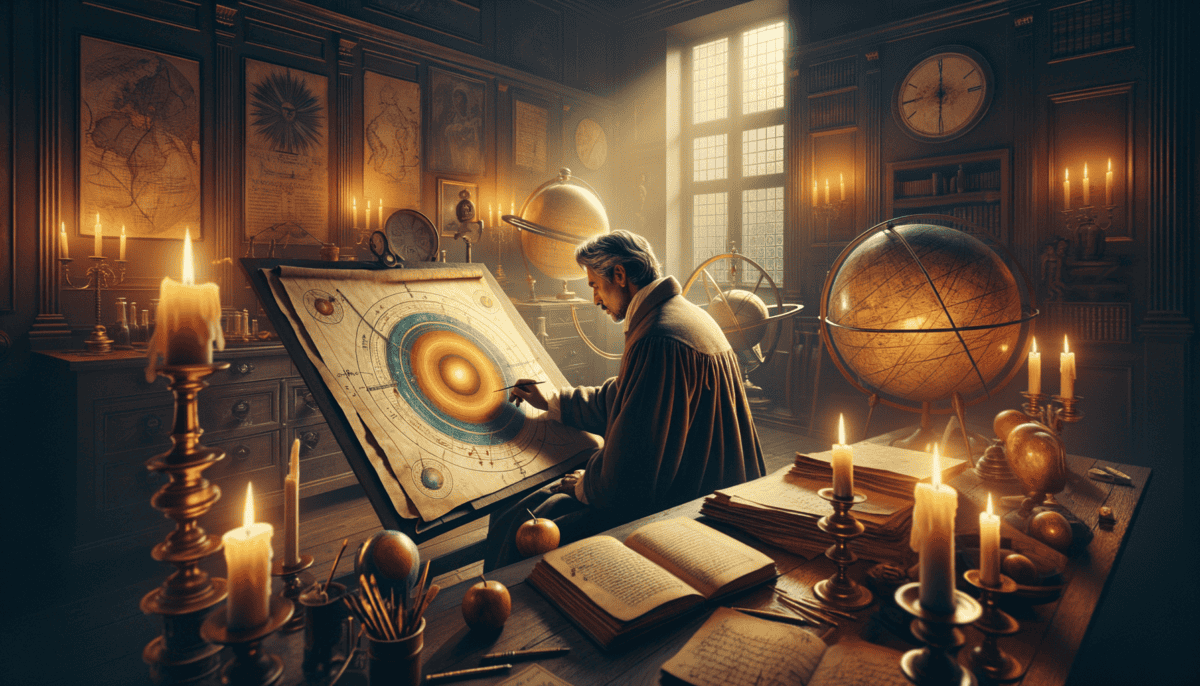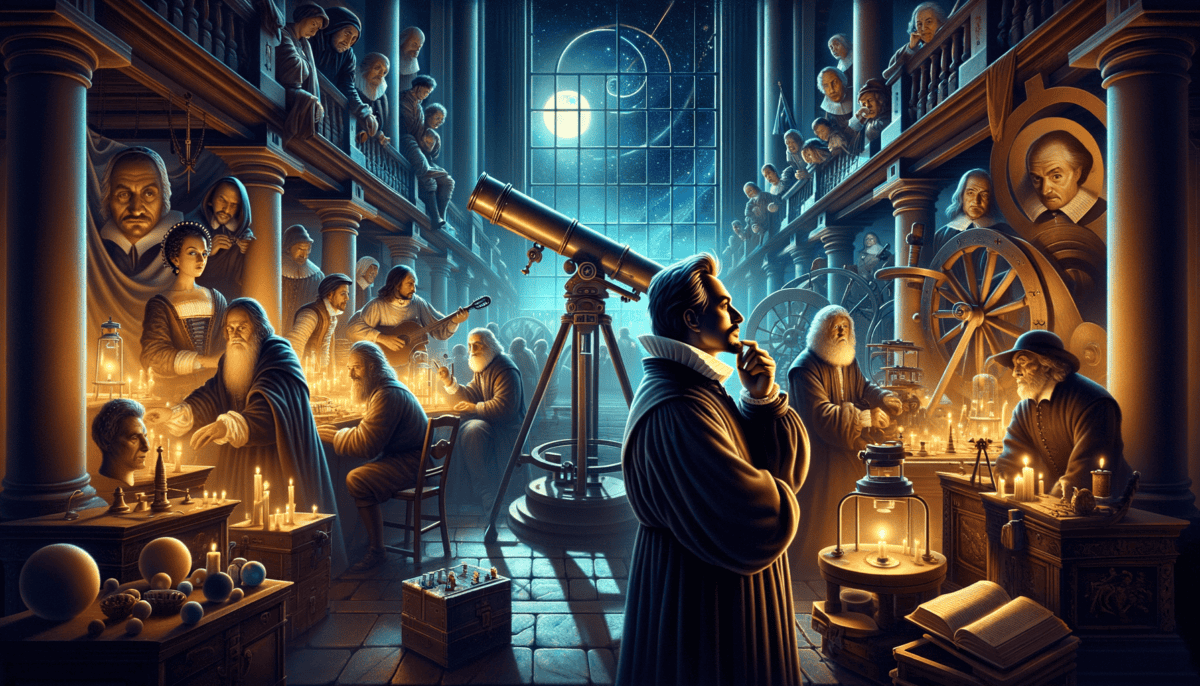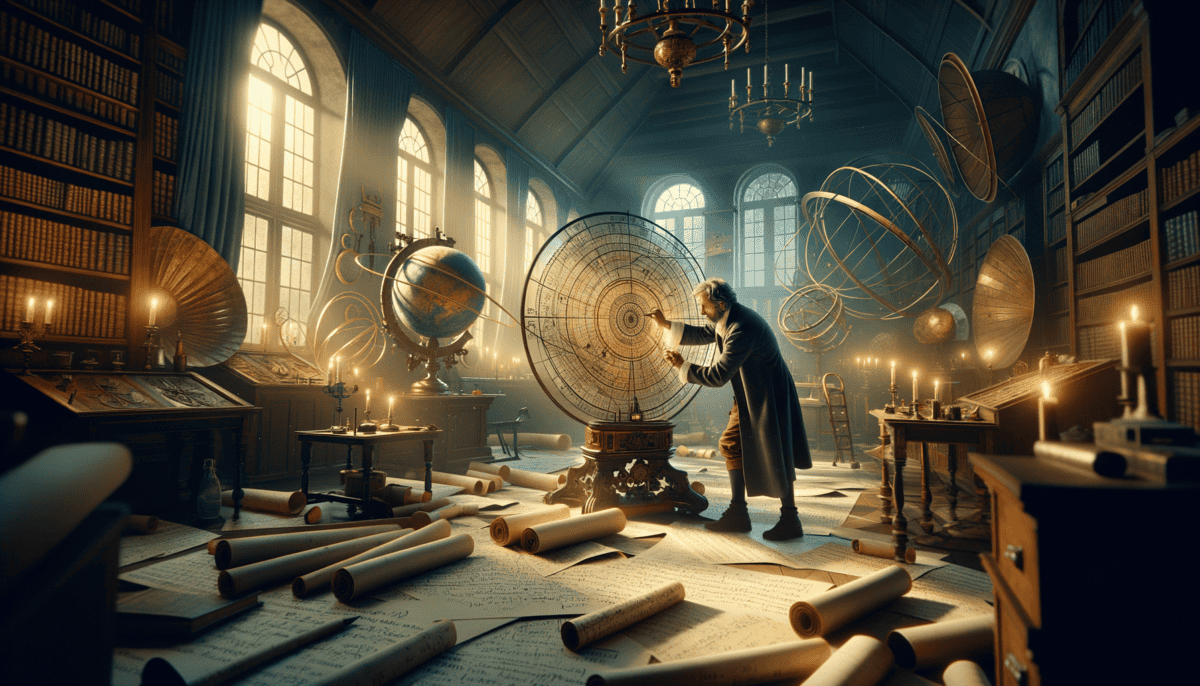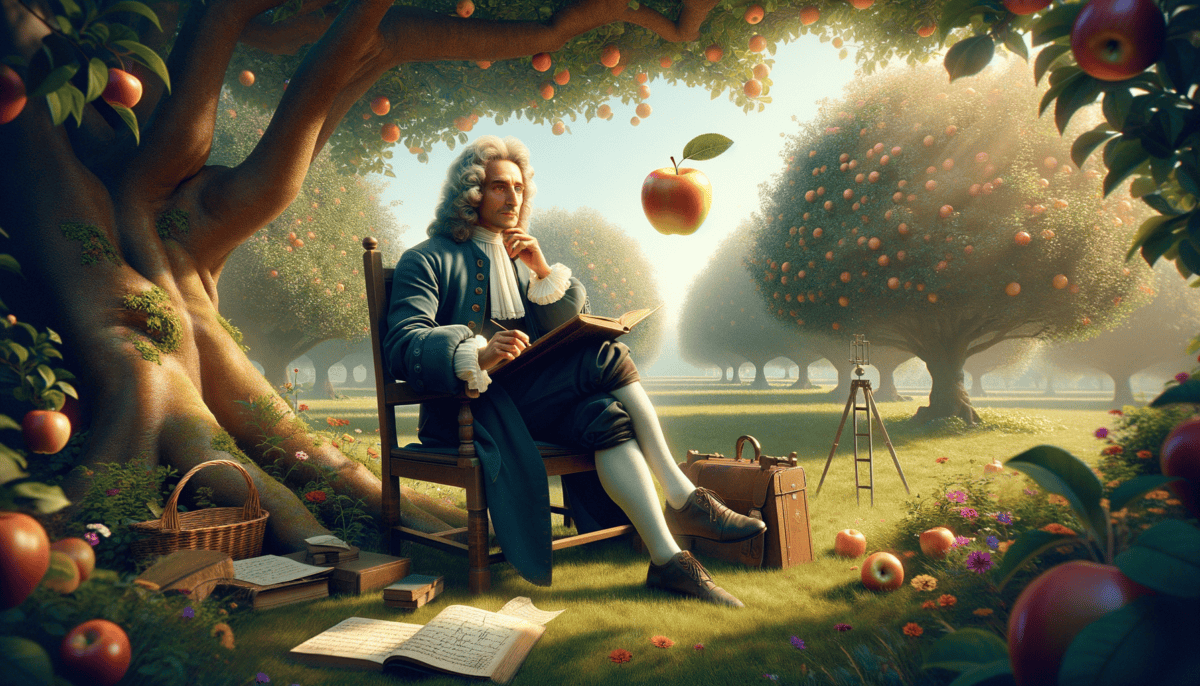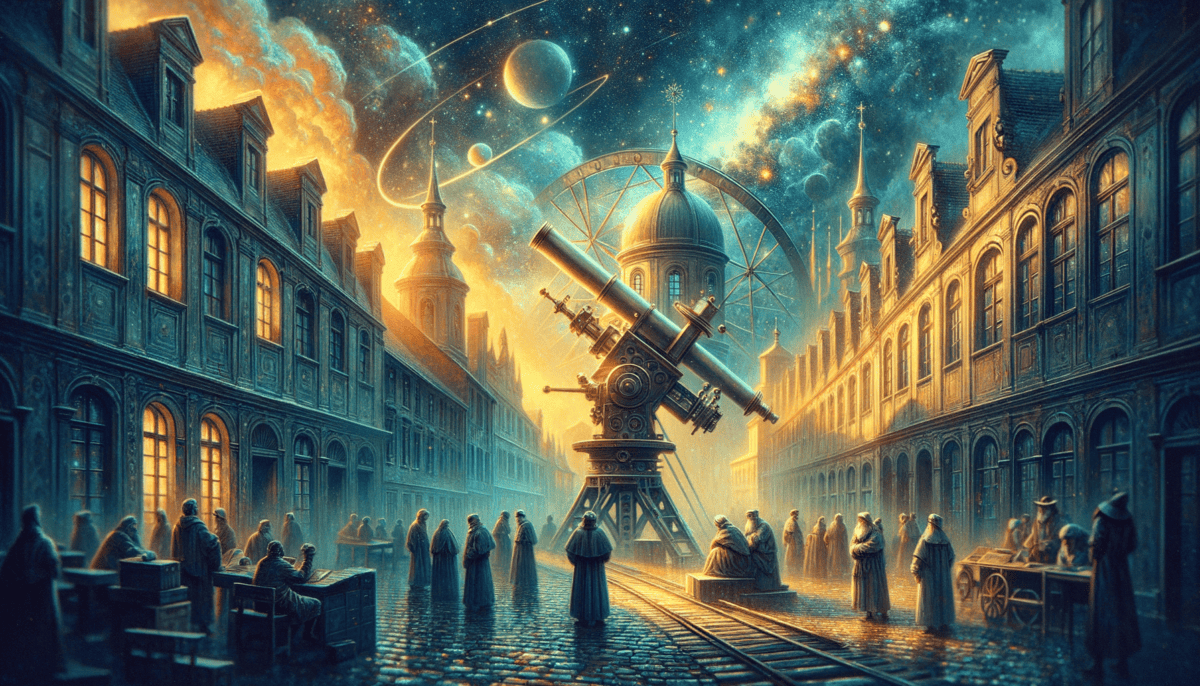A World of Questions
Little Marco peered through his bedroom window at the twinkling stars above. The year was 1510, and the night sky over Venice sparkled with countless mysteries.
"Papa, why do the stars move across the sky each night?" Marco asked, his eyes wide with wonder.
His father Giuseppe, a respected scholar at the University of Padua, sat down beside him. "Ah, my curious son. The great teacher Aristotle explained this long ago. Everything in the heavens circles around our Earth, which stands still at the center of God's creation."
But Marco wasn't satisfied. He noticed something that made him scratch his head. "Then why does the bright red star Mars sometimes move backward?"
Giuseppe shifted uncomfortably in his chair. The Church taught that the heavens were perfect and moved in perfect circles. Yet Mars did seem to dance strangely…
The next morning, Marco visited his favorite place – the marketplace by the Grand Canal. Merchants from distant lands brought not just spices and silks, but also new ideas and questions about the world.
"Did you hear?" whispered Antonio, the spice merchant. "A Polish scholar named Copernicus is saying crazy things. He thinks the Earth moves around the sun!"
Marco's eyes grew wide. "But that's impossible! Isn't it?"
The old marketplace echoed with the day's activities:
- People saying Earth was the center
- Sailors using stars to guide ships
- Merchants bringing news of new ideas
- Church leaders teaching old beliefs
- Young minds starting to question everything
A Spark of Change
That evening, Marco couldn't stop thinking about what he'd heard. He drew circles in the dirt, trying to imagine Earth spinning through space.
"What if everything we believe is wrong?" he wondered aloud.
His father placed a gentle hand on his shoulder. "Marco, sometimes the biggest discoveries start with the smallest questions. But be careful – new ideas can be dangerous."
The candle flickered as Marco wrote in his secret notebook: "Today I learned that maybe the world isn't exactly as everyone says. And that's both scary and exciting!"
As night fell over Venice, more stars appeared in the darkening sky. Somewhere out there, a revolution was beginning – not with swords or armies, but with questions and dreams of brave thinkers who dared to imagine a different universe.
The old world of fixed ideas was starting to crumble, and young minds like Marco's would help build something new in its place. But first, they had to dare to ask the questions that others were afraid to whisper.
Through his window, Marco watched a shooting star streak across the heavens. He smiled, knowing that tomorrow would bring new questions, new ideas, and perhaps even new truths about our place among those distant lights.
A Bold New Theory
The quiet halls of the University of Frauenburg buzzed with excitement. Nicolaus Copernicus, now a respected mathematician, had been working on something big.
“Professor Copernicus, is it true?” young Anna, the caretaker’s daughter, whispered as she dusted the library shelves. “Are you really saying the Earth moves?”
Copernicus glanced nervously around the empty library. His hands trembled as he pulled out his worn notebook. “Come, child. Let me show you something amazing.”
On a large piece of parchment, he drew a beautiful circle. “See this bright spot in the middle? That’s our sun. And here,” he moved his quill in a circle, “this is Earth, dancing around it.”
Anna’s eyes grew wide. “But Father Thomas says Earth doesn’t move!”
“Ah,” Copernicus smiled kindly. “Sometimes what we think we know isn’t always right. Look up at the sky every night. Watch carefully. The stars tell us their secrets if we’re brave enough to listen.”
Secret Studies
In his private study, Copernicus worked late into the night. His friend Georg Rheticus helped him write down his ideas:
- The sun stays still in the middle
- Earth spins around like a top
- Earth travels around the sun
- The stars don’t move – we do!
- Other planets also circle the sun
“But why keep it secret?” Rheticus asked one evening. “The world should know!”
Copernicus sighed deeply. “New ideas can frighten people. They might not be ready.”
A Brave Choice
Years passed, and Copernicus grew older. His friends begged him to share his discovery with the world. Finally, he agreed to write a special book called “On the Revolutions of the Heavenly Spheres.”
“What if I’m wrong?” Copernicus wondered. “What if everyone laughs?”
But deep in his heart, he knew the truth. The numbers didn’t lie. His calculations showed again and again – Earth was not the center of everything.
“Look, Anna,” he said one evening, pointing to Mars in the night sky. “See how it seems to move backward sometimes? That’s because our Earth is moving too, like children playing ring-around-the-rosy with the sun.”
Anna, now grown, smiled. “You’ve taught me to question everything, Professor. To look up at the sky with new eyes.”
As Copernicus put the finishing touches on his book, he knew he might face anger and fear from those who didn’t want things to change. But sometimes, the truth is worth being brave for.
The stars twinkled above his window, seeming to wink their approval. A new way of seeing the universe was about to change everything – and it all started with one person brave enough to imagine something different.
Through Galileo’s Eyes
The warm Italian night buzzed with excitement as Galileo Galilei adjusted his new telescope. The year was 1609, and he was about to see things no one had ever seen before.
“Papa, what do you see?” whispered Virginia, his daughter, as she watched him point the long tube toward the sky.
“Come look,” Galileo said, helping Virginia peer through the telescope. “See those bright dots near Jupiter? They’re moving! They’re moons, just like our moon, but they dance around Jupiter instead of Earth.”
Virginia gasped. “But Teacher Maria says everything moves around Earth!”
Galileo smiled gently. “Sometimes what we’re taught isn’t the whole story. Let me show you something else amazing.”
The Moon’s Secret Face
Every night, Galileo drew what he saw through his telescope. The moon wasn’t smooth like everyone thought – it had mountains and valleys! He showed his drawings to his students at the University of Padua.
“Look with your own eyes,” he told them. “Don’t just believe what old books say.”
News of Galileo’s discoveries spread quickly. Some people were excited, but others were scared of these new ideas.
Standing Up for Truth
“Mr. Galileo,” called Marco, his young neighbor. “My father says you’re in trouble for saying Earth moves around the sun. Is that true?”
Galileo nodded seriously. “I’ve seen proof through my telescope. Copernicus was right – Earth isn’t the center of everything.”
The Church leaders weren’t happy. They told Galileo to stop teaching these new ideas. But Galileo knew what he saw was real.
“Look through the telescope yourself,” he offered to anyone who would listen. Some did, but others refused.
The Big Test
One day, Galileo was called to Rome. The Church leaders wanted him to say his ideas were wrong.
“What will you do, Papa?” Virginia asked worriedly.
Galileo hugged his daughter. “I’ll tell them what I’ve seen. The truth is like those stars up there – even if clouds cover them, they’re still shining.”
He knew he might get in trouble, but he also knew something important: when you discover something true, you should share it with the world. Even if it’s scary. Even if some people don’t want to hear it.
That night, as father and daughter looked at the stars together, Virginia understood what her father always said: “The universe is written in the language of mathematics, and its characters are triangles, circles, and other geometric figures.”
The moon glowed brightly above them, no longer a perfect, smooth circle, but a real place with mountains and valleys – just waiting for curious minds to explore its mysteries.
Dancing with the Stars
Johannes Kepler sat at his wooden desk, surrounded by stacks of numbers and charts. The candlelight flickered as he studied the careful observations of Mars that his teacher, Tycho Brahe, had left him.
“These numbers must tell a story,” he whispered to himself, running his fingers through his messy hair. “But what kind of dance are the planets doing?”
A Special Shape
“Master Kepler!” called his young assistant, Franz. “Are you still working on those Mars calculations?”
Kepler looked up with excited eyes. “Yes, and I think I’ve found something amazing! The planets don’t move in perfect circles like everyone thought. They move in special oval shapes called ellipses!”
“Sometimes the simplest answer is the right one,” Kepler smiled. “We just have to be brave enough to see it.”
Here are the three big things Kepler discovered about how planets move:
- Planets move in oval paths around the sun
- They speed up when closer to the sun
- The time they take to go around the sun follows a special pattern
Making Music with Math
“But why do they move like this?” Franz asked, peering at Kepler’s drawings.
Kepler’s eyes sparkled. “It’s like music, Franz! Each planet plays its own note in the great song of the universe. And we can hear this song through mathematics!”
He picked up his quill and started writing fast. Numbers and shapes filled the page as he worked to show how the planets danced together in space.
Sharing the Dance
Some people didn’t believe Kepler at first. “Planets must move in perfect circles!” they said. “That’s what we’ve always believed!”
But Kepler knew better. He had the numbers to prove it.
“Look,” he would say, showing his calculations to anyone who would listen. “The numbers don’t lie. This is how our solar system really works!”
A New Way of Seeing
One evening, as Kepler watched the sunset, Franz joined him again.
“Master Kepler,” the boy said, “do you think anyone will use your discoveries to do more amazing things?”
Kepler smiled and pointed to the darkening sky. “Someone will. Maybe they’ll even figure out why the planets dance the way they do. There’s still so much to learn about our beautiful universe.”
As the first stars appeared, Kepler thought about how far science had come. From Copernicus’s bold idea that Earth moved around the sun, to Galileo’s brave observations, and now his own mathematical discoveries – piece by piece, they were understanding the greatest dance of all: the dance of the cosmos. ⭐
A Force That Moves Mountains
Young Isaac Newton sat under his favorite apple tree at Woolsthorpe Manor. The sun was setting, painting the sky in beautiful orange and pink colors. He watched as an apple fell from a branch above.
“I wonder,” he thought, tapping his chin. “What makes things fall down? And is it the same force that keeps the moon in the sky?”
The Big Question
“Master Newton!” called his friend Robert Hooke. “Still daydreaming under that tree?”
“Not daydreaming, Robert,” Isaac smiled. “I’m thinking about a force that might connect everything in the universe. Something invisible but very powerful.”
“What if the same thing that makes apples fall…” Isaac’s eyes lit up, “…also keeps the planets moving around the sun?”
Making Things Clear
Isaac spent many days and nights working with numbers and doing experiments. He used special tools called prisms to study light and colors.
He also made up new kinds of math to help explain his ideas. His friend Edmund Halley encouraged him to write everything down in a big book.
• Things keep moving unless something stops them
• The harder you push something, the faster it moves
• When you push something, it pushes back just as hard
Sharing the Secret
“But will people understand?” Edmund asked one evening as they looked at the finished book.
“They must,” Isaac replied. “These aren’t just ideas – they’re laws that explain how everything moves, from tiny dust specks to huge planets!” ⚡
His book, called “Principia,” changed how people thought about the whole universe. It showed that simple rules could explain big things.
Looking to the Stars
One night, Isaac and Edmund stood watching the stars.
“Look there,” Isaac pointed to a bright comet. “Now we can predict exactly where it will go, using math and the laws of gravity.”
“It’s amazing,” Edmund smiled. “You’ve helped us understand the dance that Kepler saw. Now we know why the planets move the way they do!”
The stars twinkled above as Isaac thought about all the scientists before him – Copernicus, Galileo, and Kepler. Each one had added a piece to the puzzle. Now, with his laws of motion and gravity, people could finally understand how the whole universe worked together.
“There’s still more to learn,” Isaac whispered to the night sky. “Always more to discover.” ✨
The Legacy of Stargazers
The sun rose brilliantly over London’s Royal Society, where scientists gathered to celebrate amazing discoveries. Little Tommy, age 8, held his grandfather’s hand as they walked up the grand steps.
“Grandpa, tell me again about the brave scientists!” Tommy’s eyes sparkled with curiosity.
“They were dreamers and explorers,” Grandpa smiled, “who changed how we see everything around us.”
A Special Exhibition
Inside, displays showed the tools that helped unlock the universe’s secrets. There was Galileo’s telescope, Kepler’s charts, and Newton’s prism. ⭐
“Look, Tommy!” A friendly scientist named Dr. Sarah pointed to a beautiful model of the solar system. “This shows what Copernicus discovered – that Earth moves around the sun.”
The Story Continues
“But Grandpa,” Tommy asked, watching the model spin, “did they find out everything about space?”
Dr. Sarah laughed gently. “Oh no, Tommy! We’re still discovering new things every day. Just last week, we found a new planet around another star!”
Tommy’s eyes grew wide. “Really? Can I be a scientist too?”
New Adventures Begin
Today’s scientists use big telescopes, fast computers, and special rockets to learn even more about our universe. They’re just like those brave scientists from long ago – curious and full of questions!
“Look at this, Tommy,” Dr. Sarah showed him a glowing screen. “We can now see things Galileo could only dream about. There are billions of stars and planets out there!”
“Every discovery starts with a question,” Grandpa said softly. “Just like Copernicus asking ‘What if?'”
The Greatest Gift
As the sun set, Tommy and his grandfather stood outside. The first stars were appearing in the darkening sky. ✨
“You know what the best thing is about science, Tommy?” Grandpa asked.
“What?” Tommy looked up eagerly.
“It’s that anyone can do it. All you need is curiosity and courage – just like those first brave scientists had.”
Tommy squeezed his grandfather’s hand and pointed to a bright star. “I have a question about that one!” he said excitedly.
Grandpa smiled, knowing that the spirit of those brave scientists lived on in curious minds like Tommy’s. The greatest revolution of all was learning that we never stop learning.
“Tell me your question, Tommy,” Grandpa said. “Let’s explore together.”


